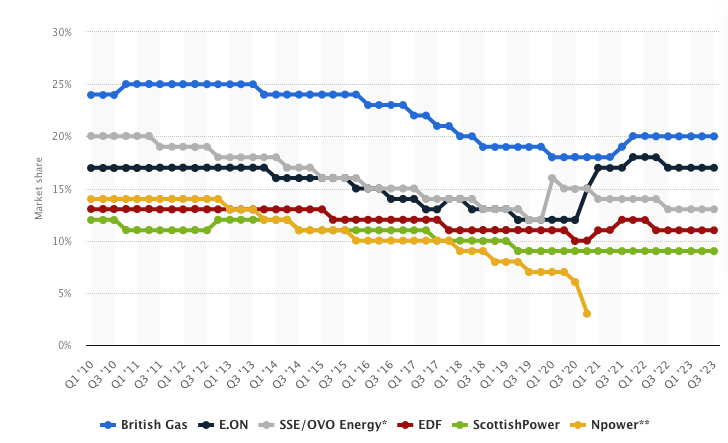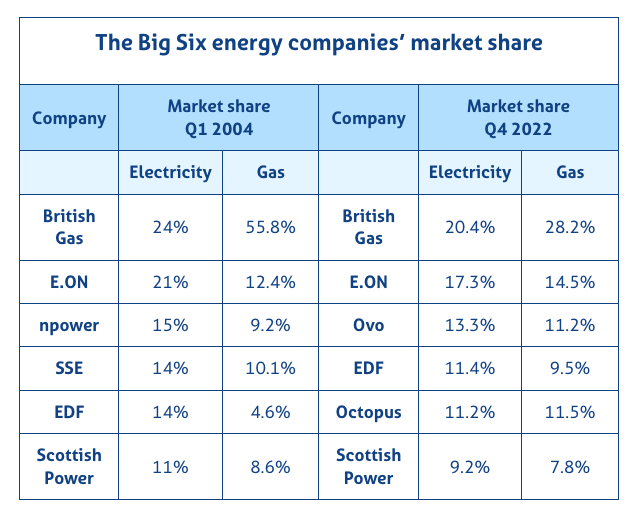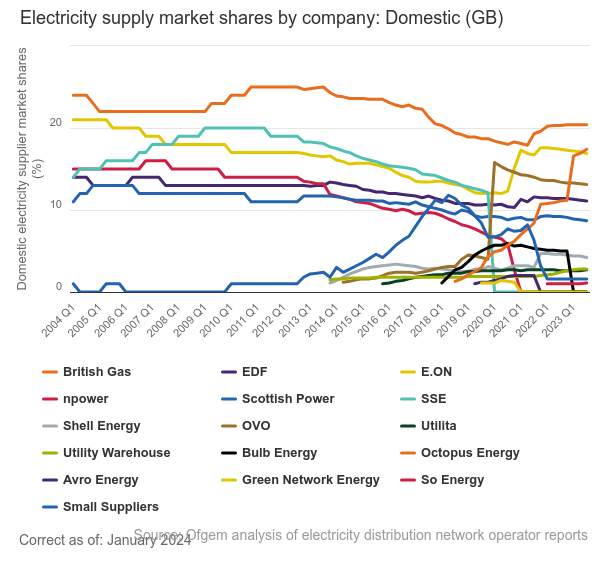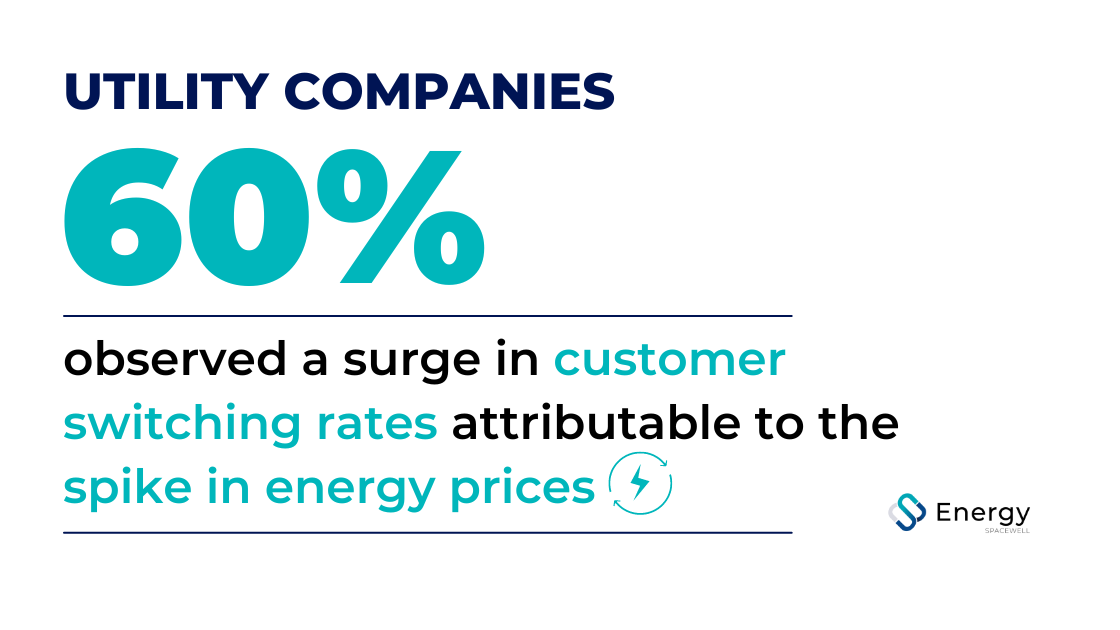Utilities are a key player with which almost all individuals or companies must interact. Organizations require energy to carry out their business activities, and therefore seek out the utilities that provide the best service.
In last week’s article, we delved into the context of Energy Service Companies, examining their challenges, priorities, and trends. Today, we shift the focus to utilities. Interested in uncovering the current market dynamics in the UK and understanding the pivotal role played by utilities in promoting energy efficiency? If so, continue reading for insightful details.
If you are part of a utility, this article may address several of the challenges you face in your day-to-day operations. You can compare the points discussed with your own experience. Do you find any similarities?
Utility Companies in the UK
The Big six companies, including British Gas, EON Next, SSE/Ovo, Npower, EDF Energy, and Scottish Power, are the largest utility companies in the UK. Following the acquisition of Npower by E.ON in November 2019, we could consider the “Big Six” became the “Big Five.”
The graph below illustrates the market shares of the Big Six energy companies in Great Britain’s domestic electricity supply market.
Source: Statista
As of the end of 2022, there were 22 active energy suppliers in the UK. The OFGEM, known as the Office of Gas and Electricity Markets, regulates these utilities. It oversees energy companies to ensure compliance with rules and regulations and protects consumer interests. However, the composition of the Big Six has changed since energy companies were privatized. Here you can see the changes from 2004 to 2022.
During the peak of the “Big Six”, these companies provided gas and electricity to 72% of British households and businesses. Nonetheless, a multitude of smaller suppliers are increasingly penetrating the UK market, providing competition and more options for customers. These newcomers not only affect the customer base of the major six suppliers but also redefine their status.
Upon closer examination of the graph down below, it becomes apparent that Octopus Energy and OVO Energy have rapidly expanded their market share, solidifying their positions among the Big Six, while SSE and Npower have ceased supplying domestic gas customers. This highlights the substantial shifts in the energy market since the early 2000s regarding dominant suppliers.
Source: Ofgem analysis of electricity distribution network operator reports
Energy Services offered by Utility Companies
If you work in a utility, surely you are aware that simply selling energy and delivering it to the user is no longer enough. In the current energy landscape, utilities play an important role in promoting energy efficiency.
The 2023 Energy Survey underscores the utilities’ proactive responses to market demands for sustainability and cost-effectiveness in energy efficiency services. All utility respondents (100%) are actively providing these services, acknowledging their crucial role in enhancing customer relationships and preserving a competitive advantage.
Now, we will delve into the energy services utilities prioritise.
Energy Efficiency Management Services
80% of utilities offer Energy Efficiency Management services, which encompass monitoring, control, and optimization. This highlights their dedication to providing comprehensive solutions that empower customers to manage energy consumption effectively.
For those not well-versed in the energy sector, it might be unexpected to learn that Utilities provide services aimed at promoting energy efficiency and reducing consumption. It may appear paradoxical for a company that profits from supplying energy to advocate for less usage.
As a utility, you face a delicate balancing act. But there’s a silver lining. Let’s explore two ideas on how you can achieve this balance:
- You can assist consumers in reducing their energy consumption while still billing for additional services.
- You can consider slower growth by helping customers consume less. Although this may not generate direct additional revenue, it will increase their loyalty and prevent them from switching to competitors.
The options are numerous and varied, and your choice will largely depend on the capabilities and services already offered by your utility. It’s essential to carefully explore different alternatives, considering aspects such as service feasibility, rates, and potential consumer offerings. By evaluating these variables, you can make an informed decision that best aligns with the challenges your utility faces.
Electric Mobility Services
Recognizing the significance of sustainable transportation solutions, 60% of utilities provide electric mobility services. This positions them as crucial facilitators in addressing the infrastructure and management requirements associated with the increasing adoption of electric vehicles.
Photovoltaic Solar Energy Solutions
6% of utilities are actively involved in Solar Energy Projects, enabling the seamless integration of solar power into customers’ energy portfolios. This initiative aligns with the worldwide trend toward embracing renewable energy sources.
Utilities are reactive in providing services associated with photovoltaic solar energy and self-consumption. However, there is a noticeable trend towards the proliferation of services such as supplying solar energy, aiding in panel installation, maintenance, and financing among them.
In recent years, the adoption of solar panels in the UK has been on the rise. Last year, the cumulative capacity reached in the UK was 17.6 GW. This trend is anticipated to persist in 2024, with the UK solar capacity projected to increase by over 2 GW.
Energy Certification for Offices and Facilities
40% of utilities provide Energy Certification for offices and facilities, assisting customers in obtaining recognition for their energy management endeavors and bolstering their reputation as environmentally responsible organizations.
Energy Infrastructure Services
Likewise, 40% of utilities offer planning and implementation services for energy infrastructure, demonstrating a strategic emphasis on building resilient and efficient energy systems capable of adapting to future shifts in consumption patterns and technological advancements.
Challenges faced by Utilities
Year after year, utilities face various challenges that they must address. In the context of a volatile and challenging energy market like the one we experienced in 2023, customer turnover rates and energy prices emerge as two critical variables for organizations.
In this context, in this year’s Energy Survey, we explore how these dynamics are affecting energy management and customer relationships.
High attrition rate among Utility Companies
The 2023 Energy Survey delves into the crucial correlation between customer switching rates and energy price volatility, particularly pertinent for utilities in today’s economic climate. In sectors marked by high dynamics and competition, it’s common for consumers to frequently change suppliers. This trend is evident in industries such as banking, telecommunications, and the energy sector. The intense competition often results in attractive offers that draw in customers seeking better prices, advice, or new services.
The survey findings reveal that 60% of utilities have observed a surge in customer switching rates, directly attributable to the significant spike in energy prices. This underscores customers’ heightened sensitivity to cost fluctuations and their inclination to seek out competitive rates or alternative energy solutions.
Despite these challenges, not all utilities face the same impact. For instance, 20% have experienced no notable change in switching rates but have received requests for contract adjustments, indicating customers negotiating terms with their current providers.
Another 20% report no discernible impact on switching rates, suggesting a segment less affected by price increases or prioritizing factors such as service quality, reliability, and sustainability commitments.
In response, utilities are reassessing their customer engagement strategies and pricing models, underscoring the necessity for tailored services, flexible pricing plans, and energy efficiency initiatives. Moreover, the survey highlights utilities exploring differentiation through advanced technologies for customer analytics, loyalty programs, and partnerships to expand service offerings.
It’s important to note that the attrition rate at a national or European level is not the same as the overall attrition rate for all utilities, unlike the customer churn rate which each utility calculates internally. However, they are related figures that can be used as a benchmark.
Attrition rate in Europe
According to a study conducted in 2021, the highest turnover rates are observed in the Netherlands, Belgium, and Norway. At the same time, we must consider that a high turnover rate can be beneficial for the market, as it indicates that the process of switching between providers is relatively simple and flexible for the consumer.
From the perspective of a professional in an energy supplier, the loss of customers is not perceived as particularly positive. Therefore, it is crucial to take into consideration the points mentioned in this article. Offering value-added services to your customers, as well as possible adjustments according to their needs or guidance, may be essential to maintain their loyalty. Furthermore, a high turnover rate in the market also indicates that you have the opportunity to attract new customers.
At Spacewell Energy, we encourage you to continuously improve your services, and we are pleased to accompany you in this process. If you would like more information on how Spacewell Energy can help you access new tools and solutions, please do not hesitate to contact us.








